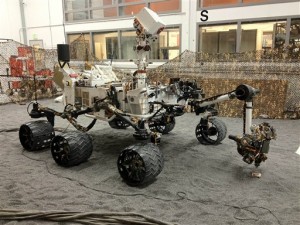
In this photo provided by the Jet Propulsion Laboratory via Honeybee Robotics, a duplicate of the rover Curiosity that remains on Earth and is used for testing purposes, is shown here poised to use the Dust Removal Tool on the grounds of the Jet Propulsion Laboratory in Pasadena, Calif. The dust removal tool was designed and built by Honeybee Robotics. While spacecraft technology companies often make their home out West in California and Texas, the engineers at Honeybee Robotics assemble their products right along New York City’s Westside Highway. (AP Photo/Jet Propulsion Laboratory via Honeybee Robotics, Kyle Brown)
LOS ANGELES — Neil Armstrong inspired millions with his moonwalk. Can a feisty robotic rover exploring Mars do the same for another generation?
With manned missions beyond the International Space Station on hold, the spotlight has turned on machines.
The newest, the rover called Curiosity, last week beamed home photographs of its first wheel tracks on the Martian soil since its daredevil landing this month. While it did not rise to Armstrong’s “one small step for man, one giant leap for mankind,” interest was so high in the rover’s “seven minutes of terror” approach to the red planet that NASA’s website crashed.
“There’s something exciting about reaching another place in the solar system. If you think about the kind of interest the landing of Curiosity had, you get a sense of that,” said Smithsonian Institution space curator Roger Launius. It wasn’t on the same level as Armstrong’s feat, “but it was pretty darn exciting,” he said.
When Armstrong, then fellow astronaut Buzz Aldrin, stepped on the moon on July 29, 1969, an estimated 600 million people watched and listened. “Virtually the entire world took that memorable journey with us,” recalled Buzz Aldrin after Armstrong’s death on Saturday.
Early in the Space Age, the Mercury, Gemini and Apollo astronauts were the public face of NASA’s space endeavor while the unmanned lunar missions that paved the way were in the shadows. The public craved adventure and the manned missions delivered. Aiming for the moon was new and exciting — not to mention dangerous. And the U.S. was locked in a Cold War space race with the Soviets.
Next, the space shuttle ferried a new crop of astronauts to low-Earth orbit, but after three decades of service, it became routine. And the Cold War thawed with the Russians and Americans cooperating on the Russian space station Mir and the International Space Station.
With the space shuttle fleet retired, the International Space Station is all that’s left. Its crew of six for the most part quietly goes about doing its job about 250 miles (400 kilometers) above the Earth. President Barack Obama nixed plans for returning astronauts to the moon in favor of landing on an asteroid and eventually Mars.
These days, space exploration is carried out by robotic spacecraft — commanded by human handlers on Earth. Advances in technology have allowed unmanned spacecraft to go farther and peer deeper, with craft circling Mercury, Saturn, asteroid Vesta and others headed for Jupiter and dwarf planet Pluto. The twin Voyager craft are still going strong at the fringes of the solar system 35 years after their launch in 1977.
American University space policy analyst Howard McCurdy said today’s generation of explorers was raised on technology and tends to get more jazzed about delivering a car-size rover to Mars.
“Robotic exploration has taken more of a center stage,” he said. “It gets more publicity now than the International Space Station.”
When the first Mars rover Sojourner landed in 1997, science fiction writer Arthur C. Clarke paraphrased Armstrong’s famous line and said the event was “one small step for the rover.”
Three other rovers have followed including Curiosity, which landed Aug. 5 by executing an intricate routine that ended with it being lowered by cables to the surface. Curiosity’s acrobatics proved so popular that some 1.1 million people now follow it on Twitter (the first person accounts are being written by the public affairs office at the NASA Jet Propulsion Laboratory, which manages the $2.5 billion mission.)
Curiosity chief scientist John Grotzinger said Monday the wheel prints on Mars may turn out to be an iconic image just like those first boot prints on the lunar surface.
“Instead of a human, it’s a robot pretty much doing the same thing,” he said.
Henry Lambright, a professor of public policy and space scholar at Syracuse University, said while Curiosity is inspiring, the world still needs to send humans beyond low-Earth orbit.
“It can’t inspire to the degree that Apollo did because a robot can’t inspire the way a man can,” Lambright said.
On Monday, NASA played a recording from Administrator Charles Bolden that had been sent up to the rover on Mars and relayed back to Earth. In it, he thanked scientists and engineers for their achievement.
David Lavery of NASA headquarters said the hope is that someone will be inspired by Bolden’s message and become the first human to stand on Mars.
“Like the great Neil Armstrong, they’ll be able to speak aloud — the first person at that point, of the next giant leap in human exploration,” he said.